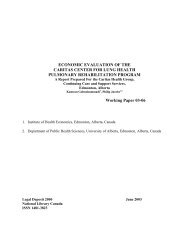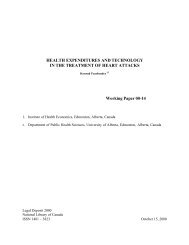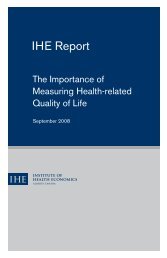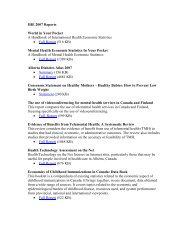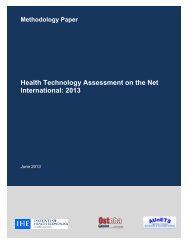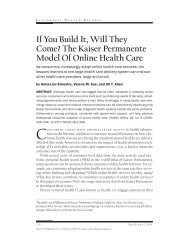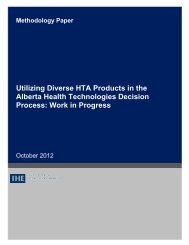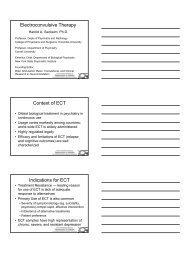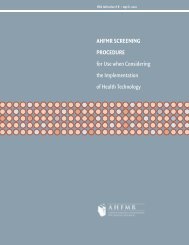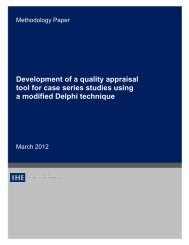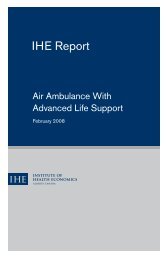Bariatric treatments for adult obesity - Institute of Health Economics
Bariatric treatments for adult obesity - Institute of Health Economics
Bariatric treatments for adult obesity - Institute of Health Economics
- No tags were found...
You also want an ePaper? Increase the reach of your titles
YUMPU automatically turns print PDFs into web optimized ePapers that Google loves.
High-density lipoprotein (HDL): a <strong>for</strong>m <strong>of</strong> cholesterol that circulates in the blood, commonlycalled “good” cholesterol. An HDL <strong>of</strong> 60 mg/dl or greater is considered high and is protectiveagainst heart disease. An HDL <strong>of</strong> less than 40 mg/dl is considered low and increases the risk <strong>for</strong>developing heart disease.<strong>Health</strong>y weight: a body weight that is less likely to be linked with any weight-related healthproblems (such as type 2 diabetes, heart disease, high blood pressure, high blood cholesterol, orother problems). A BMI between 18.5 kg/m 2 and 25 kg/m 2 is associated with a healthy weight,although not all individuals with a BMI in this range may be at a healthy level <strong>of</strong> body fat (they may,<strong>for</strong> example, have more body fat and less muscle tissue).Heart attack: the death <strong>of</strong> heart muscle due to the loss <strong>of</strong> blood supply. Loss <strong>of</strong> blood supply isusually caused by a complete blockage <strong>of</strong> a coronary artery, one <strong>of</strong> the arteries that supplies blood tothe heart muscle. Death <strong>of</strong> the heart muscle, in turn, causes chest pain and electrical instability <strong>of</strong>heart muscle tissue.Heart disease: any disorder that affects the heart. Heart disease is synonymous with cardiac diseasebut not with cardiovascular disease, which is any disease <strong>of</strong> the heart or blood vessels. Types <strong>of</strong>heart disease include angina, arrhythmia, congenital heart disease (CHD), coronary artery disease(CAD), dilated cardiomyopathy, heart attack (myocardial infarction), heart failure, hypertrophiccardiomyopathy, mitral regurgitation, mitral valve prolapse, and pulmonary stenosis.Herbal: a term referring to herbs, and which may reflect the botanical or medicinal aspects <strong>of</strong> herbs.Hormone: a chemical substance produced in the body. Hormones control and regulate the activity<strong>of</strong> certain cells or organs.Hypertension: repeatedly or consistently elevated blood pressure, characterized by a blood pressuremeasurement exceeding 140 over 90 mmHg.Hypothyroid: a deficiency <strong>of</strong> thyroid hormone (the hormone normally produced by the thyroidgland).Incidence: the frequency with which a disease appears in a particular population or area, defined asthe number <strong>of</strong> cases newly diagnosed during a specific time period.Incoherence statistic: the difference between direct and indirect evidence.Insulin: a natural hormone made by the pancreas that controls the level <strong>of</strong> the glucose in the blood.Insulin permits cells to use glucose <strong>for</strong> energy. Cells cannot use glucose without insulin.Insulin resistance: the diminished ability <strong>of</strong> cells to respond to the action <strong>of</strong> insulin in transportingglucose (sugar) from the bloodstream into muscle and other tissues. Insulin resistance typicallyheralds the onset <strong>of</strong> type 2 diabetes.Laparoscopy: direct visual examination <strong>for</strong> diagnostic or therapeutic purposes <strong>of</strong> the abdominalcavity, where the abdominal cavity has been previously distended by means <strong>of</strong> an endoscopeintroduced through the abdominal wall.Laparotomy: (also called open surgery) surgical incision through the abdominal wall and peritoneum.Lean body mass: the mass <strong>of</strong> the body minus the fat (storage lipid). A number <strong>of</strong> methods exist <strong>for</strong>determining lean body mass, including underwater weighing (hydrostatic weighing), dual-energy X-ray absorptiometry, and bioelectric impedance analysis.<strong>Bariatric</strong> <strong>treatments</strong> <strong>for</strong> <strong>adult</strong> <strong>obesity</strong> – March 2012xix



